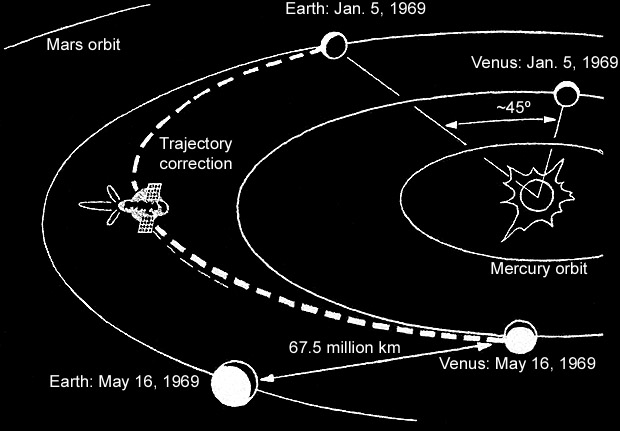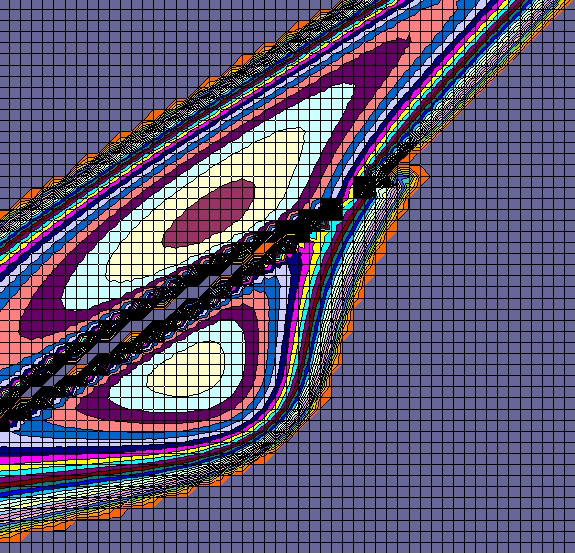Ballistic Interplanetary Trajectories
To first approximation, the optimum trajectory is an elliptical Hohmann Orbit, tangent to the Earth's orbit at aphelion and tangent to Venus' orbit at perihelion. Every 583.92 days (the synodic period of Venus) a launch window occurs, during which nearly optimal paths can begin at Earth and arrive at Venus. The diagram above illustrates the flight plan of Venera-5.
Every 5 synodic cycles, the relative configuration of Earth and Venus repeats almost exactly. This is called the metonic cycle. Because planetary orbits are not coplanar or perfectly circular, launch windows have different associated flight durations and payload costs.

The orbit of Venus is nearly circular, but its large angle of inclination primarily accounts for differing mission costs (for Mars, the major issue is the eccentricity of its elliptical orbit). The plot of launch date versus arrival date, sometimes called a pork-chop plot, shows payload costs during the 1972 opportunity. The optimum launch date was March 27, requiring 112 days and 6.1 megajoules per kilogram of payload. The Soviet Union made two Venus launches that year, on March 27 and March 31. As seen above, two local optima exist, a shorter Type I trajectory, which goes less than halfway around the Sun, and a longer (Type II) trajectory. In 1972, a cheaper Type II trajectory left on April 4, took 170 days and cost 4.1 megajoules per kilogram. Type I trips result in communications distances of around 60 million kilometers between Venus and Earth, upon probe arrival. Type II trajectories were not used for fly-by or impactor missions because the communications distance would be several times greater. When saving energy is important or launch scheduling is constrained, longer orbits may be used. For long-term orbiter missions, it is also less critical to optimize for arrival distance. For example, Pioneer-13 was send on a Type II path and required a large solid-fuel retro rocket to slow it to orbital speed, during that year's energetically unfavorable trajectory. Magellan reached Venus via a Type IV trajectory, going one and a half times around the Sun. Venus Missions |
| Launch Date | Spacecraft | Mission | Origin | Outcome |
| 1959, Jun 13 | Unused Type I window | |||
| 1961, Feb 4 | 1VA No. 1 | impactor | USSR | Stranded in parking orbit |
| 1961, Feb 12 | Venera 1 | impactor | USSR | Attitude control sensor overheated |
| 1962, Jul 22 | Mariner 1 | flyby | USA | Crashed in North Atlantic |
| 1962, Aug 25 | 2MV-1 No.1 | lander | USSR | Stranded in parking orbit |
| 1962, Aug 27 | Mariner 2 | flyby | USA | First successful planetary mission Venus has small magnetic field |
| 1962, Sep 1 | 2MV-1 No.2 | lander | USSR | Stranded in parking orbit |
| 1962, Sep 12 | 2MV-2 No.1 | photo-flyby | USSR | Stranded in parking orbit |
| 1964, Mar 27 | 3MV-1 No.5 | lander | USSR | Stranded in parking orbit |
| 1964, Apr 2 | Zond 1 | lander | USSR | Pressure loss/corona discharge |
| 1965, Nov 12 | Venera 2 | flyby | USSR | Thermal control failure |
| 1965, Nov 16 | Venera 3 | lander | USSR | Thermal failure First impact on another planet |
| 1965, Nov 23 | 3MV-4 No. 6 | flyby | USSR | Explosion in parking orbit |
| 1967, Jun 12 | Venera 4 | lander | USSR | First planetary-atmosphere probe Crushed at attitude of 25 km |
| 1967, Jun 14 | Mariner 5 | flyby | USA | Fly-by, radio occultation |
| 1967, Jun 17 | V-67 No. 2 | lander | USSR | Stranded in parking orbit |
| 1969, Jan 5 | Venera 5 | lander | USSR | Successful, but crushed at 18 km |
| 1969, Jan 10 | Venera 6 | lander | USSR | Successful, but crushed at 18 km |
| 1970, Aug 17 | Venera 7 | lander | USSR | First successful planetary landing |
| 1970, Aug 22 | V-70 No. ? | lander | USSR | Stranded in parking orbit |
| 1972, Mar 27 | Venera 8 | lander | USSR | Measured surface illumination |
| 1972, Mar 31 | 3V | lander | USSR | Stranded in parking orbit |
| 1973, Nov 3 | Mariner 10 | photo-flyby | USA | First good pictures of Venus Gravity assist to Mercury |
| 1975, Jun 8 | Venera 9 | lander/orbiter | USSR | First pictures of surface, 4-month orbital photo study of clouds |
| 1975, Jun 14 | Venera 10 | lander/orbiter | USSR | Same as Venera 9, one of two cameras failed on each lander |
| 1977, Jan 9 | Unused Type I window | |||
| 1978, May 20 | Pioneer 12 | orbiter | USA | Radar mapping, photo study of clouds, operated 14 years |
| 1978, Aug 8 | Pioneer 13 | impactors | USA | Cluster of 5 atmosphere probes |
| 1978, Sep 9 | Venera 11 | lander/flyby | USSR | Spectra from clouds to surface, atmosphere chemical analysis |
| 1978, Sep 14 | Venera 12 | lander/flyby | USSR | Both color cameras, rock analysis failed on both 11 and 12 |
| 1980, Mar 25 | Unused Type I window | |||
| 1981, Oct 30 | Venera 13 | lander/flyby | USSR | Color images, rock analysis |
| 1981, Nov 4 | Venera 14 | lander/flyby | USSR | Color images, rock analysis |
| 1983, Jun 2 | Venera 15 | orbiter | USSR | High resolution radar mapping |
| 1983, Jun 7 | Venera 16 | orbiter | USSR | High resolution radar mapping |
| 1984, Dec 15 | Vega 1 | lander/flyby | USSR | Night landing, balloon probe Halley's comet encounter |
| 1984, Dec 21 | Vega 2 | lander/flyby | USSR | Same as Vega 1 |
| 1986, Oct 11 | Unused Type I window | |||
| 1988, Mar 22 | Unused Type I window | |||
| 1989, May 4 | Magellan | orbiter | USA | High resolution radar mapping |
| 1989, Oct 18 | Galileo | flyby | USA | Images, gravity assist to Jupiter |
| 1991, Jun 5 | Unused Type I window | |||
| 1993, Jan 5 | Unused Type I window | |||
| 1994, Aug 9 | Unused Type I window | |||
| 1996, Mar 20 | Unused Type I window | |||
| 1997, Oct 15 | Cassini | flyby | USA | Images, gravity assist to Saturn |
|
|